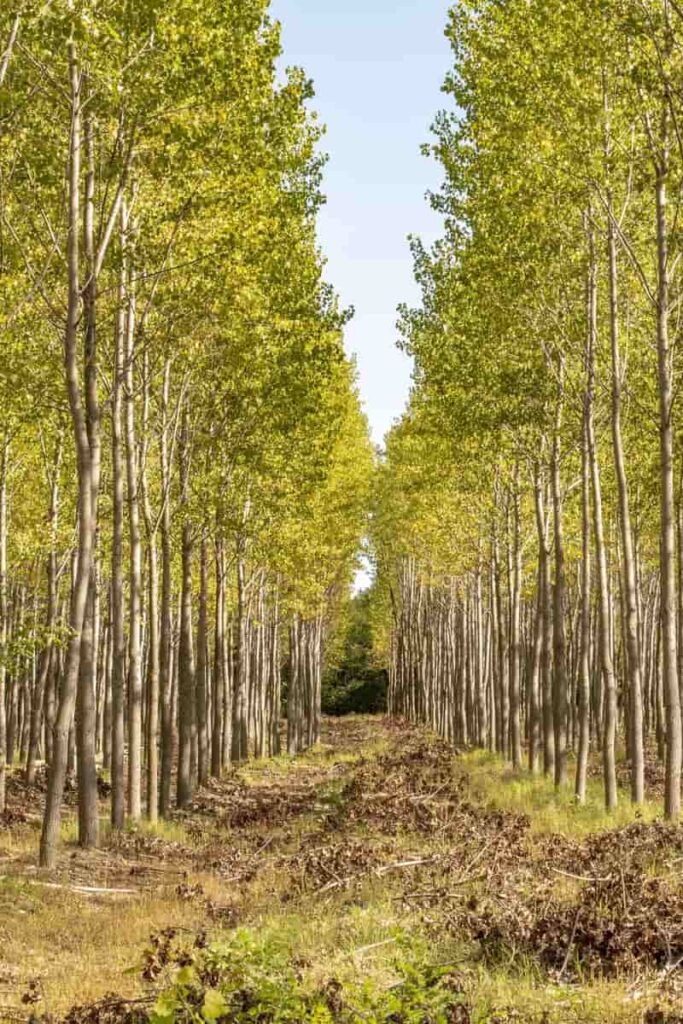Poplar trees grow rapidly but are relatively short-lived. They are widely distributed across northern temperate regions, including North America, Eurasia, and northern Africa. The leaves are oval or heart-shaped in outline with fine to coarsely toothed leaf edges. As a result of their flat leaf stalks, the leaves tremble in the breeze. Usually, aspen poplar trees have nonsticky buds and grayish-green bark in North America. Conversely, cottonwoods and balsam poplars have darker and deeply furrowed bark and sticky buds.
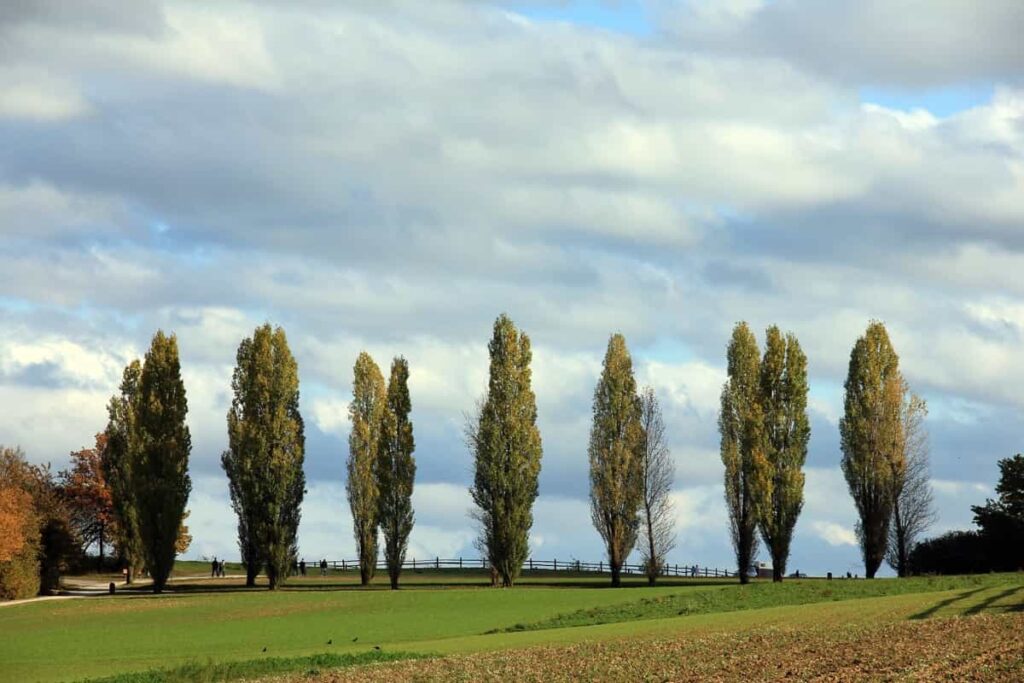
There are wide varieties of poplar trees, and they grow rapidly, making them popular among homeowners. These are fast-growing, solid, easy-to-grow trees that produce drooping clusters of flowers known as catkins. Before the leaves emerge, the flowers bloom in drooping catkins, which makes wind pollination easier. There are many minute seeds in each fruit covered in silky tufts of cottony hairs, enclosed in small thick-walled capsules. Often, many seeds are released, and the fluffy seed hairs assist in dispersal by the wind.
How to grow Poplar tree
Different Poplar tree varieties
A poplar tree’s foliage is a good indicator of its variety. It is often heart-shaped, and if you observe closely, it has small teeth around the edges. Leaf color changes from green to golden or yellow in the fall, based on the variety. These trees produce male and female flowers meaning they are self-pollinating. As a result, the plant produces yellow flowers and small fruits. Selecting a suitable variety for your garden and caring for it properly can extend its lifespan. The number of recognized species is over 35, but few of them are commonly grown in domestic environments. These are the most common types of plants
White Poplar
The white Poplar is also known as the silver Poplar. It grows to 60 to 100 feet in height and is the closest relative of the aspen species. Although it is a short-lived tree, it provides excellent shade and has large, dark leaves. The leaves of this tree have fuzzy white undersides, giving it a silver or white appearance.
Black Poplar
Trees such as Populus heterophylla poplar can thrive in wet conditions that other trees cannot. Typically, the leaves are oval-shaped and light or dark green with a different color underside. It can grow to a height of 50 to 100 feet at maturity and acquire a lumpy, dark-colored bark with age. A black poplar tree has triangular leaves that turn a distinctive golden-yellow color in the fall. This tree thrives in wet and swampy areas, known as the swamp cottonwood. In this cultivar, the branches are tall and narrow, giving it a columnar shape.
Balsam poplar
Balsam poplar is a more common poplar species found in the Northern U.S. It is most commonly recognized for its shiny, oval leaves with resin-dotted undersides. Their narrow, pointed leaves emit a distinct smell reminiscent of balsam fir trees, hence the name balsam poplar. Once fully mature, this type of poplar tree reaches a height of 75 to 100 feet. The wood of balsam Poplar is often used to make pulp wood, particleboard, and boxes.
Western balsam poplar
Western balsam poplars, also known as black cottonwoods and California poplars, can grow up to 150 feet tall. The leaves are heart-shaped or oval, and the buds release a balsam scent in spring. The bark of the California poplar is so hard and gnarled that cutting it with a chainsaw can cause sparks. As it has an extensive root network, it can grow on steep slopes, causing damage to buildings and land. Despite its preference for wet soil and sunlight, it can survive in various climates.
Trembling Poplar
A trembling poplar is also named a quaking aspen tree or mountain aspen because of its long branches called petioles that quake in the wind. Tall trunks with smooth white bark characterize trembling poplars.
In case you missed it: Contract Sheep Farming in India: Companies, Agreement, Profits, How it Works and the Pros and Cons
Necklace poplar
Known as Cottonwood Poplar, it reaches around 80 feet in height and 60 feet in spread, making it another large tree. Despite drought tolerance, its dark green leaves will turn yellow in the fall. Ash-gray bark appears on mature plants. These trees need nutritionally dense and wet soil at all times, so they are very sensitive to soil changes. Due to its vulnerability to wind, it is best planted in areas with little wind or other trees that can provide support. Even though this Poplar is vulnerable to wind, it is relatively resistant to frost and cold winters.
Lombardy Poplar
One of the most popular cultivars is Lombardy. Lombardy grows about 6 feet a year, making it a good choice for windbreaks or privacy screens. Lombardy has an unusual branching structure that contributes to the iconic column shape of the poplar tree. Branch growth begins near the ground and moves upward parallel to the trunk. This cultivar isn’t grown for its autumn foliage, unlike other cultivars, despite its yellow foliage in the fall. Lombardy’s trunk also blackens with age, another distinctive characteristic.
How to propagate and grow Poplar trees from cuttings
- Choose a healthy branch that does not show any signs of disease, damage, or insect infestation. Find a branch that has grown roughly the width of a pencil from the current year. The branch should have at least four buds, or growth nodes, on its end, which should be cut with pruning shears.
- Fill five-gallon bucket three-quarters full of water. Put the cutting in water after removing leaves from the lower third to half of it. Three days of soaking are recommended for the cutting.
- The best place to plant your garden is one that receives six to eight hours of sunlight each day and has well-draining soil. Break up the soil using a tiller up to 10 to 12 inches deep at the planting site. Tilling it over ensures the soil is loose and free of large chunks.
- The cutting should be removed from the bucket of water. Apply rooting hormone to the cutting’s bottom end.
- Make a 3 to 6-inch deep and 3-inch wide hole using a trowel in the prepared spot. The bottom one-third of the cutting should be inserted into the hole. Hand-pack the soil firmly around the cutting after backfilling the hole.
- The cutting should be watered until puddles form around its base with a garden hose. The water should be allowed to drain, and the soil should be repacked if needed. Apply more water to ensure the soil around the cutting is thoroughly moistened.
- Mulch the base of the cutting with a ring of 1 to 2 inches thick. Mulch should not touch the cutting to prevent mold growth.
- The ground around the cutting should be thoroughly and deeply moistened while it develops roots. The ground should be moist but not soggy during the first season of the cutting. Once the poplar tree has reached its second growing season, it should only be watered when there is little rainfall or drought.
- Fertilize the Poplar cutting each spring with a slow-release fertilizer containing 10-10-10 nitrogen, phosphorous, and potassium. Mix 1 tablespoon fertilizer into the 6 inches of topsoil per square foot of ground. You can activate fertilizer release by watering the area to 6 inches deep.
In case you missed it: Agriculture Courses Offered in India – List of Agricultural Universities and Colleges
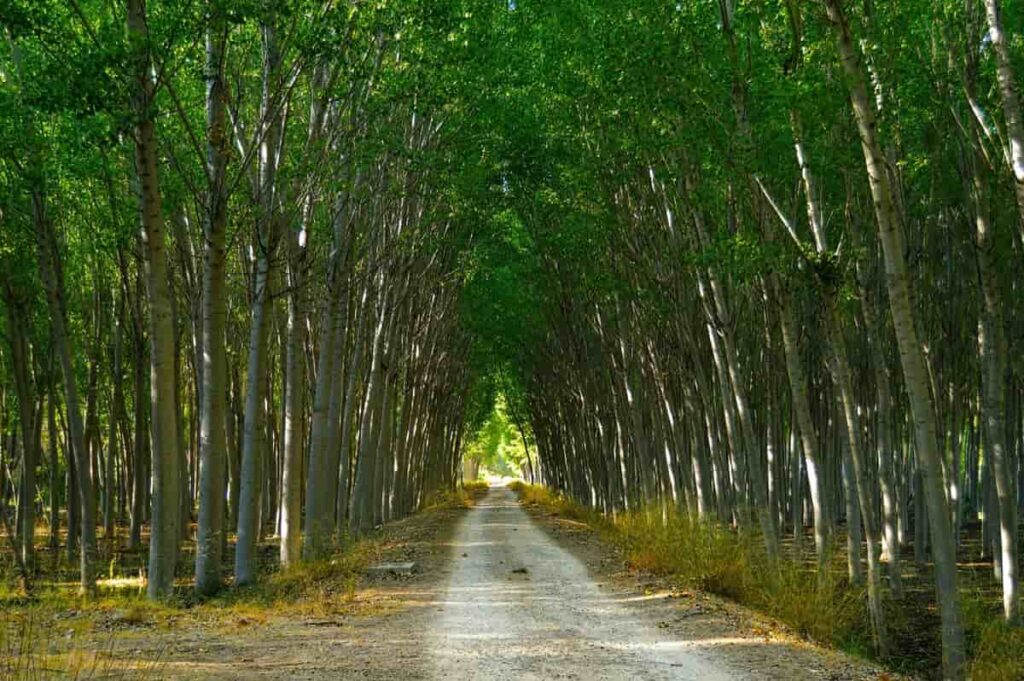
Poplar tree care
Required soil type and soil preparation for healthy growth of Poplar tree
Trees such as Poplar will tolerate various soil types as long as the soil drains well and does not pool stagnant water. All types of soil are acceptable for Poplar, including light clay, sand, loam, and humus. Adding coarse sand, small aggregate, peat, and perlite to heavy clay soils or soils with poor drainage will improve drainage and oxygenation.
In ideal soil pH ranges between 6.0 and 8.0, Poplar thrives in slightly acidic and alkaline soils. Sulfur or any other acidifier should be added to the soil above 8.0 or very alkaline. Lime or other base amendments will improve the pH of very acidic soils. In addition, topdressings of amendments can keep the pH in the proper zone if needed.
How much and which type of sunlight is required for a Poplar tree
Full sun is best for the poplar tree, but partial shade will also work. These plants require direct sunlight for a minimum of six hours a day. In an area with less sun, the poplar tree may grow slower, resulting in fewer issues, with branches growing overly fast and suffering from wind and storm damage. Additionally, it will result in less pruning and less maintenance, repair, and damage costs if an unfortunate incident occurs.
When and how much water needs your Poplar tree
Lakes, rivers, streams, creeks, and rivers are common places where Poplar trees grow. Although they are thirsty trees, extra watering will go a long way, especially when they are young, even in somewhat dry areas. During the first few years of life, water liberally. In the dry summer months, it’s essential to water your poplar trees every week unless you planted them in wetlands near rivers or lakes. Poplar trees can be protected from canker diseases by regular watering.
How to fertilize your Poplar tree
It is not recommended to provide it with supplemental fertilizer unless severe soil deficiencies are causing it harm. Before fertilizer is applied, a simple soil test should be conducted to determine if the soil is the problem. Most likely, the issues with the tree are caused by a pathogen or insect, not a lack of nutrients.
Mulching for the Poplar tree
Place a couple of inches of mulch between your poplar trees after planting them. Compost helps fertilize new poplars, and shredded leaves or grass can also be used as mulch. By doing so, weeds are prevented from growing, and moisture is retained in the soil. The mulch should not be thicker than 4 inches for poplar trees to grow properly.
Pruning for the Poplar tree
Pruning will be the most important in all the care that can and will be given to a poplar tree. Regular pruning will need to be done to reduce wind exposure starting a full year after planting the tree. A good structure must be established early in life through pruning.
In case you missed it: How to Grow African Violets: A Guide to Propagation, Planting, and Care
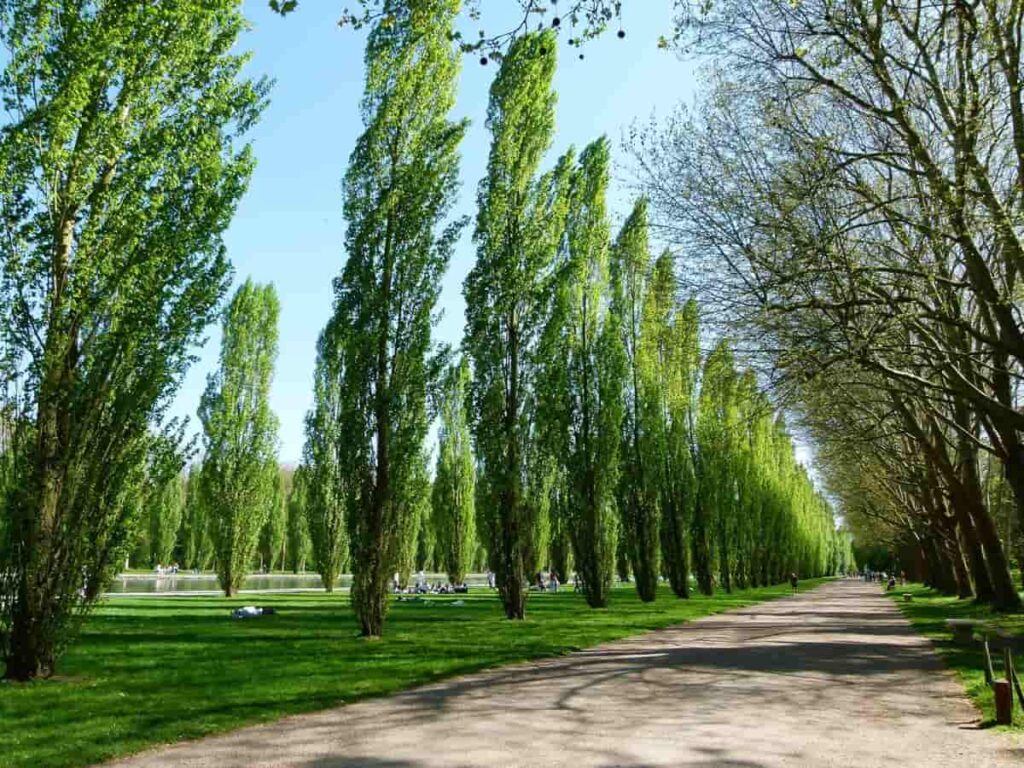
As the tree grows, it must eliminate any harsh crotches and intersections and establish a singular leader or trunk to ensure its strength. Branches should be cut to form a pattern away from the tree’s leader, as the tree will naturally have an oval crown. Ensure that dead, dying, or damaged branches are checked every year. It will only take a few years for the work to move from the ground to a ladder due to the fast growth of these trees. Now is the time to call in the pros, which means searching for a certified arborist who can handle the work safely.
Common pests and diseases in a Poplar tree
Pests
Pest | Symptoms | Control methods |
| Poplar tentmakers | Newly hatched larvae skeletonize the leaf, and older larvae devour all except the leaf stalk | Neem extract or Bacillus thuringiensis should give adequate control to poplar tentmakers. |
Cottonwood leaf beetle | The larvae skeletonize the underside of the leaves. The adult feeds on the leaf; it forms holes and, in some cases, consumes the leaf entirely. | Spraying azadirachtin provides good suppression |
Aphids | Heavily-infested leaves can wilt or turn yellow and senesce prematurely because of excessive sap removal. | Horticultural oil is highly effective in controlling aphids, but only if you thoroughly treat the tree. Apply the oil in the dormant season to kill any overwintering eggs. |
Twig pruners | The adults will chew a hole in the bark of a leaf near a twig tip and lay an egg. The larva bores into the twig and feeds and tunnels toward the twig’s base. | During the fall or winter, collect fallen branches from the ground, prune infested branches still in the tree, and burn them. |
In case you missed it: Vertical Saffron Farming: The Red Gold Revolution for Excellent Profits
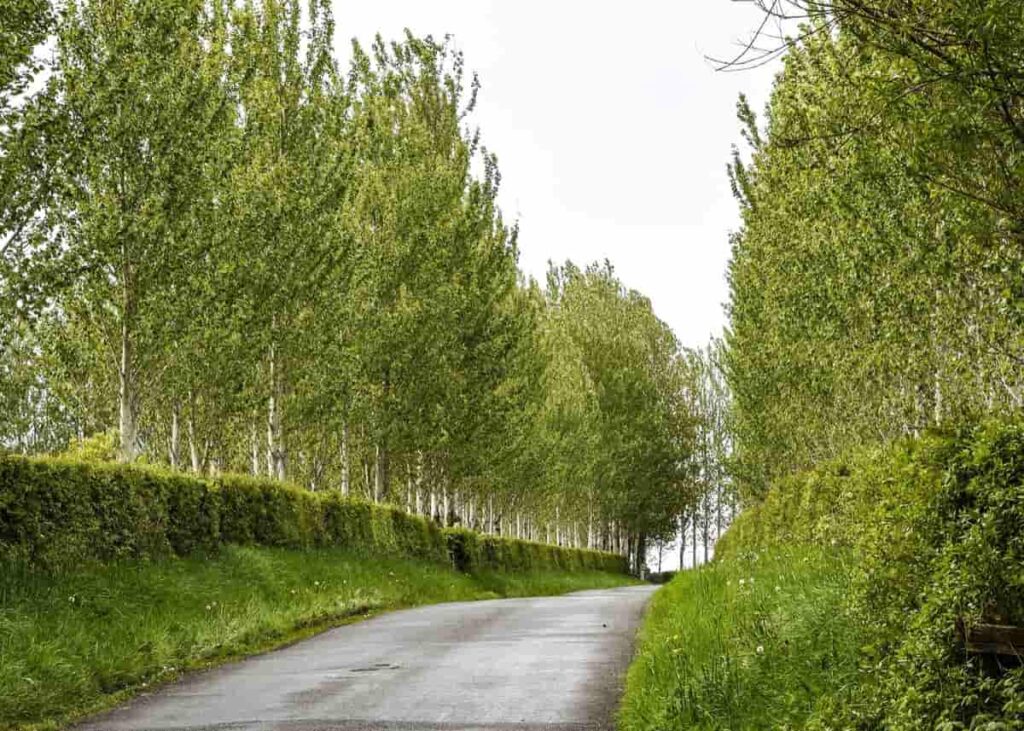
Diseases
| Disease | Symptoms | Control methods |
Gray spot | Cause: Coryneum populinum Symptoms: small, water-soaked, round, ovate, or irregular spots on leaves as initial infections. The inner part of the spot is a shiny gray color. | Spray infected trees with Pyraclostrobin solution for better control of the gray spots. |
Rust | Bright orange to yellow bumps develop on the underside of leaves in the later part of the growing season | Applying a registered fungicide in a plantation can be helpful at the onset of a rust infection, especially during hot, humid weather. |
Growing Poplar Trees in containers
In a container, poplar trees are not suitable for long-term growth. It is certainly possible, but the cold winter weather will damage the roots, and the sheer size of the tree will eventually make the pot an unstable medium for growing it. Growing this tree in a container is not recommended; instead, choose a spot in the ground where it will thrive.
In case you missed it: Croton Plant Care in India: Exclusive Tips for Beginners
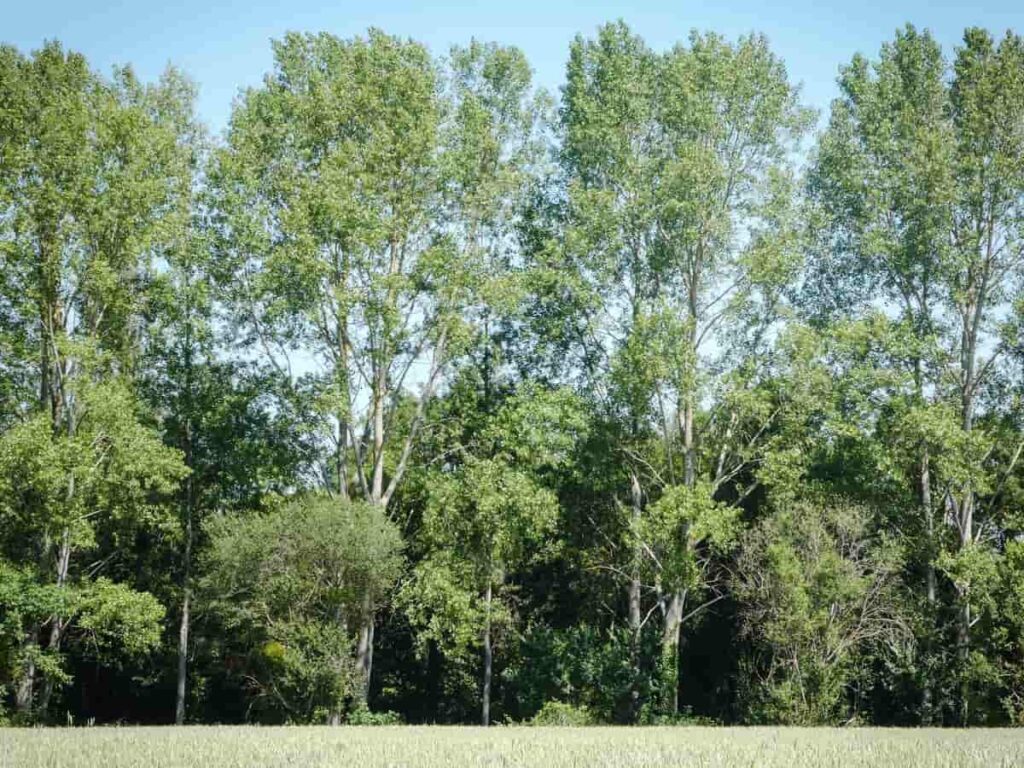
How fast do poplar trees grow
Various varieties of Poplar grow to different heights, but they are all fast-growing. You can expect 3 to 5 feet of new growth each year. Several Poplar trees have lived over 200 years, which is unusual for fast-growing trees. Poplars generally range from 50 to 160 feet, most between 50 and 80 feet tall. Some cultivars, such as the Tulip Poplar, grow up to 70 feet tall.
Conclusion
A poplar tree adds structure and definition to a garden elegantly and attractively. As well as providing shelter or privacy, poplar trees are pleasingly easy to maintain once planted. If you follow the advice in this guide, you will help to enjoy the cool shade of the poplar trees for years to come.
- How to Raise Pigs in Your Own Backyard: A Comprehensive Guide
- Budget Friendly Sheep Shed Ideas: Cheap and Low-Cost Tips
- How Much Do Cattle Farmers Make: Revenue Streams in Cattle Farming
- Management Pests and Diseases in Your Cotton Field
- Sheep Farming Business Plan for Beginners
- Aquaponic Farming at Home: A Step-By-Step Guide
- Profitable Village Farming Business Ideas in 2024
- High-Yield Aquaculture: Fast-Growing Fish for Farming
- Effective Fish Pond Construction Techniques for Beginners
- Irrigation and Water Management in Pineapple Farming
- Blossom to Harvest: Mastering Flowering and Pollination in Papaya Farming
- Pig Fattening Essentials: From Selection to Sale for Beginners
- Raising Wagyu Cattle: A Complete Guide for Premium Beef Production
- Soil Types and Their Water Holding Capacity
- Optimizing Irrigation Schedules for Coconut Groves for Enhanced Yield
- Espresso Your Garden: Coffee Grounds for Healthier Acid-Loving Plants
- The Best Soil Mix for Snake Plants: How to Mix Your Own Snake Plant Soil
- Green Thumb Success: Expert Tips for Cultivating Greenhouse Beans All Year Round
- Bloom All Year Round: The Ultimate Guide to Indoor Hyacinth Care
- Eco-Friendly Gardening: How to Make Liquid Fertilizer from Kitchen Waste
- Ultimate Guide to Grow Anise in Pots: Explore Seed Propagation to Harvesting
- Guide to Raising Chester White Pigs: Discover Breed Facts to Growth Management
- Mastering the Elegance: The Ultimate Guide to Weeping Cherry Tree Care, Planting, and Maintenance
- Ultimate Guide to Planting Garlic in Grow Bags: Growing Strategies for Beginners
- How to Fix Spider Plant Leaf-Related Problems: Natural and Organic Remedies
- 10 Reasons Why Your Tulsi Plant is Shedding Leaves: Home Remedies and Solutions
- Optimizing Growth and Yield: The Advantages of Palm Bunch Ash Fertilizer
- Utilizing Neem Oil Extract as a Natural Pesticide for Hydrangea
- From Soil to Harvest: Various Ways in Which Farmers Can Use AI Tools
- Steps to Encourage and Induce Citrus Flowers: A Comprehensive Guide
- How to Fix Snake Plant Leaf-Related Issues: Natural and Organic Remedies
- Transform Your Garden into a Fragrant Oasis with Raat Ki Rani (Night Blooming Jasmine)
- Discover the Ideal Chicken Breeds for Philippine Farms
- How to Create a Poultry Egg Farm Business Plan for Profits
- Grow Lemon Cucumbers Like a Pro: Insider Techniques for Bountiful Yields
- Ultimate Guide to Caring for Your Pink Princess Philodendron: Tips for Thriving Variegation

